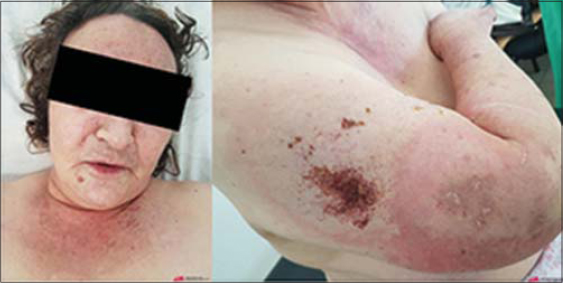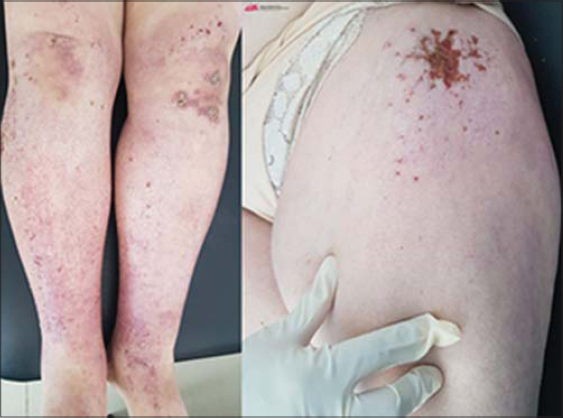Dermatomyositis revealing an endometrial papillary serous carcinoma associated with a peritoneal carcinomatosis: A case report
Hazim Aburabie 1, Nassiba Zerrouki1, Afaf Khouna1, Nada Zizi1,2, Siham Dikhaye1,2
1, Nassiba Zerrouki1, Afaf Khouna1, Nada Zizi1,2, Siham Dikhaye1,2
1Department of Dermatology, Mohammed VI University Hospital of Oujda, Mohammed First University of Oujda, Morocco, 2Laboratory of Epidemiology, Clinical Research and Public Health, Faculty of Medicine and Pharmacy, Mohammed the First University of Oujda, Morocco
Corresponding author: Dr. Hazim Aburabie
Submission: 23.07.2019; Acceptance: 13.10.2019
DOI: 10.7241/ourd.2020S3.5
Cite this article: Aburabie H, Zerrouki N, Khouna A, Zizi N, Dikhaye S. Dermatomyositis revealing an endometrial papillary serous carcinoma associated with a peritoneal carcinomatosis: A case report. Our Dermatol Online. 2020;11(Supp. 3):15-17.
Citation tools:
Copyright information
© Our Dermatology Online 2020. No commercial re-use. See rights and permissions. Published by Our Dermatology Online.
ABSTRACT
Dermatomyositis is a rare inflammatory disease of connective skeletal muscle tissues. Patients with dermatomyositis have a predisposition for the development of malignant tumors. We report the case of a 69-year-old female who presented herself with two-month face and limb erythemas, muscle weakness, followed by fifteen days of intermittent metrorrhagia. A physical examination revealed typical skin lesions, including erythema, in photo-exposed areas, ragged cuticles, and numerous ulcerations. A blood analysis revealed high muscle enzyme levels. A muscle biopsy revealed myositis and positive anti-TF1 antibodies. An endometrial papillary serous carcinoma was diagnosed by an etiological investigation and classified as stage IV by the FIGO classification. The patient was started on 2 mg/kg/day of prednisolone with concomitant palliative chemotherapy.
Key words: Dermatomyositis; Cancer; Paraneoplastic syndrome
INTRODUCTION
Dermatomyositis is a rare disease characterized by inflammatory myopathy (progressive, symmetric, proximal weakness) and typical skin lesions (Gottron’s papules, heliotrope eruptions, periungual telangiectasias, and ragged cuticles). Adults diagnosed with dermatomyositis have an increased risk of malignancy, with the most common tumors being ovarian, cervical, uterine, gastric, and colorectal [1].
We report a case of dermatomyositis revealing an endometrial carcinoma in a Moroccan female.
CASE REPORT
A 69-year-old female consulted for face and limb erythemas associated with muscular weakness present for the last fifteen days and intermittent metrorrhagia present for the last two months.
A physical examination revealed an erythema in photoexposed areas, hypertrophy, and pain of the cuticles on palpation, as well as numerous ulcerations at the lateral sides of the thighs, lateral sides of the arms, and at the finger pads (Figs. 1 – 3). Blood tests revealed high levels of muscular enzymes, and a muscle biopsy revealed myositis and positive anti-TF1 antibodies. Other examinations revealed endometrial papillary serous carcinoma. Local and general staging revealed multiple diffuse intraperitoneal nodular lesions and masses with an infiltration of mesenteric fat. Hence, the disease was classified as stage IV by the FIGO classification. The patient was started on 2 mg/kg/day of prednisolone with concomitant palliative chemotherapy.
DISCUSSION
The association between dermatomyositis and cancer has been recognized since the report of a case of dermatomyositis and cancer in 1916 by Stertz [2]. While the pathogenesis of dermatomyositis and cancer is incompletely understood, it is thought to be caused by altered humoral and cellular immunity. Myositis-specific autoantigens are expressed at high levels in several cancers known to be associated with the development of inflammatory myopathy. Neoplasia may be detected before, during, or after the diagnosis of dermatomyositis [3].
Currently, the association with lung, pancreatic, stomach, and colon cancers as well as non-Hodgkin lymphomas is well established. Ovarian cancer appears to bear the highest association with dermatomyositis (13.3–26%); breast cancer is less common (13.5%); and the association of dermatomyositis with other gynecologic malignancies, such as endometrial cancer, is relatively rare (1.7%) [2]. One patient out of ten patients with gynecological cancer had endometrial carcinoma associated with dermatomyositis [3,4].
Paraneoplastic dermatomyositis is statistically related with some clinical and biological criteria, such as the sudden onset of symptoms, necrotic lesions or periungual erythema, an age beyond 50 years, and some serum antibodies, such as antibodies to transcription intermediary factor (TIF)-gamma, anti-p155, and antibodies to nuclear matrix protein (NXP)-2, anti-MJ, and anti-p140. Conversely, the presence of myositisspecific (anti-synthetase antibodies, anti-Mi2, and antiSRP) and myositis-associated antibodies (anti-RNP, anti-PM/Scl) appears to be associated with a decreased risk of malignancy [5].
CONCLUSION
In female patients with DM, a systematic evaluation for a possible gynecologic malignancy should be performed as it may be associated with severe clinical and biological presentations. Thorough history taking and a physical examination, including a rectal examination and breast and pelvic examinations, in females should be performed, as well as a further investigation, including computed tomography, a scan of the chest, abdomen, and pelvis, colonoscopy, mammography, and a Pap smear [1].
Consent
The examination of the patient was conducted according to the principles of the Declaration of Helsinki.
REFERENCES
1. Ziani FZ, Brahmi SA, Najib R, Kanab R, Arifi S, Mernissi FZ, et al. Paraneoplastic dermatomyositis is revealing an undifferentiated nasopharyngeal carcinoma:about a case. Pan Afr Med J. 2016;24:29.
2. Famularo G. Amyopathic dermatomyositis associated with an endometrial adenocarcinoma. Our Dermatol Online. 2017;8:235-6.
3. Wada C, Hua CNC, Carne ME. Paraneoplastic syndrome in hawai’i:a case of dermatomyositis associated with endometrial cancer. Hawaii J Med Public Health. 2014;73:112–4.
4. Stawczyk-Macieja M, Szczerkowska-Dobosz A, Błażewicz I, Wilkowska A, Nowicki R. Dermatomyositis related to the relapse of cervical cancer. Our Dermatol Online. 2015;6:183-6.
5. Kasuya A, Hamaguchi Y, Fujimoto M, Tokura Y. TIF1γ-overexpressing, highly progressive endometrial carcinoma in a patient with dermatomyositis positive for malignancy-associated anti-p155/140 autoantibody. Acta Derm Venereol. 2013;93;715-6.
Notes
Source of Support: Nil.
Conflict of Interest: None declared.
Request permissions
If you wish to reuse any or all of this article please use the e-mail (brzezoo77@yahoo.com) to contact with publisher.
| Related Articles | Search Authors in |
|
 http://orcid.org/0000-0001-5921-276X http://orcid.org/0000-0001-5921-276X |






Comments are closed.